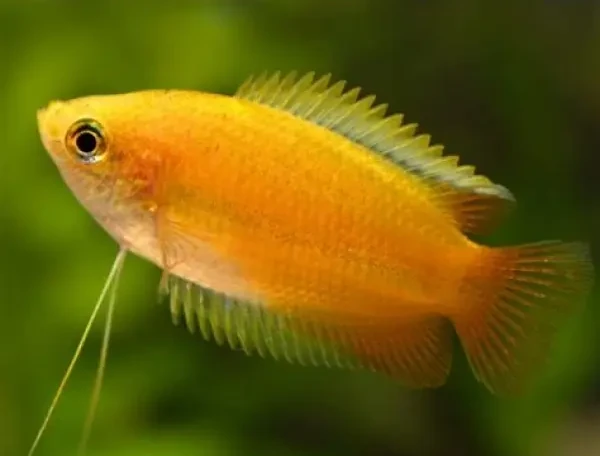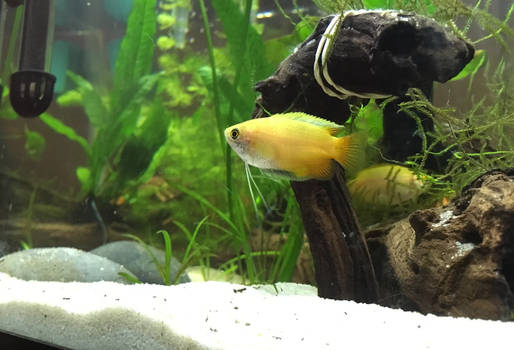Honey Gourami
The Honey Gourami, Trichogaster Chuna, often referred to as the Honeycomb Gourami or Sunset Gourami, is a beloved tropical freshwater fish, celebrated for its vibrant orange hue and gentle demeanor. Since the 1800s, Trichogaster (Colisa) chuna has captivated aquarists with its striking colors and ease of breeding in home aquariums. Its resilience and adaptability to various water conditions make it an ideal choice for beginners in the aquarium hobby.
- Experience Level: Beginner
- Hardiness: Hardy
- Minimum Tank Size: 12 gal (45 L)
- Maximum Size: 3 inches (7.6 cm)
- Temperament: Peaceful
- Temperature: 72 – 82° F (22 – 28° C)
- pH Range: 6.5 – 7.0
- Water Hardness: 5.0 – 19 dGH
- Diet: Omnivore
Table of Contents
Introduction
Size and Appearance
Care Guide
Tank Mates
Diet and Feeding
Breeding
Native to the Ganges River valley across India and Bangladesh, the Honey Gourami thrives in lakes, ditches, and rivers, preferring the sanctuary of densely vegetated areas with soft water.
Size and Appearance
Known variably as the Gold Honey Gourami, this species may look pale in store tanks but develops its namesake deep honey coloration in a well-maintained home aquarium. All Honey Gouramis in the trade are bred for the aquarium industry, with crossbreeding between Honey Gourami and Dwarf Gourami resulting in more vivid red, gold, or orange variants.
The true colors of Honey Gourami often remain hidden in overcrowded commercial tanks, revealing themselves fully only within the comfort of a personal aquarium. Typically, Honey Gouramis are small, measuring between 1.5 and 3 inches in length, with a body shape resembling a pointed oval. Their dorsal and anal fins are elongated, spanning most of their body, complemented by two lengthy feelers from their chin to their tail. They have a modest lifespan, living between 3 to 5 years.
Males and females can be differentiated by their physique and fin size, with males showcasing a slimmer profile and females possessing fuller bodies and more pronounced fins.
Care Guide
- Minimum Tank Size: 12 gal (45 L)
- pH Range: 6.5 – 7.0
- Water Hardness: 5.0 – 19.0 dGH
- Temperature: 72 – 82° F (22 – 28° C)
- Lighting: Moderate to strong lighting. Provide adequate hiding spaces.
- Substrate: Sand / Gravel
- Brackish: No
- Water Flow: Low to Mid
- Tank Region: Bottom to Middle
Honey Gouramis are an excellent option for novice aquarium enthusiasts. Originating from regions prone to monsoons and tidal fluctuations, they have adapted to endure changes in water quality. These fish can withstand variations in water chemistry, with an optimal temperature range of 72°F to 82°F (22-28°C), maintained by standard aquarium heating solutions. A quality filtration system that generates water flow is beneficial for both the fish and aquatic plants.
The preferred pH level for Honey Gouramis is slightly acidic to neutral, between 6.5 and 7.0, with water hardness being a non-critical factor. Keeping the water within the ideal temperature range ensures the well-being of your Honey Gourami. Suitable for tanks as small as 12 gallons, Honey Gouramis can coexist in groups of up to 6 in smaller aquariums. It’s advisable to maintain a balance between males and females to prevent territorial disputes among males.
Favoring the middle to upper sections of the tank, Honey Gouramis thrive in environments rich in vegetation and structures. They are partial to rooted plants like Pothos that reach the tank’s surface, where they enjoy hiding and exploring. The Amazon Sword plant is another excellent choice, with coral sand substrate being ideal for these plants. Designing your aquarium with clustered vegetation provides isolated territories for small fish groups, a strategy well-suited for larger tanks with diverse inhabitants.
For smaller tanks, dense planting around the edges with open swimming space in the center accommodates tank mates requiring free movement. A mix of vegetation types creates an engaging and stress-free environment for Honey Gouramis. Floating plants are also favored by Honey Gouramis. Integrating species like Water Lettuce and Frogbit into your setup offers the added advantage of easy maintenance.
Well-lit aquariums or those with a simulated day/night cycle are optimal for Honey Gouramis, with light timers simplifying the maintenance of a consistent lighting schedule.
Tank Mates
Honey Gouramis are peaceful and shy, making them suitable companions for similar-sized, non-aggressive fish. Opting for tank mates that inhabit lower tank levels further minimizes the risk of conflict. Avoid aggressive or fin-nipping species that will harass the gouramis.
Recommended tank mates for Honey Gouramis include:
- Tetras: Varieties including Neon Tetras, Ember Tetras, and Harlequin Rasboras are excellent companions for your tank. They offer a peaceful temperament, vibrant activity, and a splash of color to your aquarium environment.
- Corydoras Catfish: These bottom-feeders, such as Bronze or Panda Corydoras, are non-aggressive and suitable tank mates. They contribute to maintaining the cleanliness of the aquarium’s floor.
- Livebearers: Certain livebearers, like guppies or platies, are known to live harmoniously with honey gouramis, adding diversity to your tank.
- Snails and Shrimp: For those considering invertebrates, species like Nerite Snails and Cherry or Amano Shrimp prove to be compatible with honey gouramis, enhancing the biodiversity of your aquarium.
Feeding Guide
- Diet: Omnivore
- Frequency: Two small feedings per day
- Pellet Foods: Yes, use pellets formulated for small tropical fish
- Flake Foods: Yes, tropical fish flakes are suitable
- Live Foods: Yes, such as brine shrimp and micro worms
- Meat Foods: Yes, small insects and larvae
- Vegetable Foods: Yes, occasionally offer blanched vegetables or spirulina
Honey Gourami are omnivorous and exhibit a broader dietary preference compared to purely carnivorous fish species. In their natural habitat, they consume small insects and similar small prey. A variety of tropical fish food flakes or pellets are suitable as a primary diet for them. To prevent your Honey Gourami from becoming disinterested in their food, consider rotating their diet periodically.
Observe how your Honey Gouramis respond to quicker-sinking foods. Due to their timid nature, they might not vie for food with other fish residing in the middle or bottom of the tank. If that’s the case, ensure their diet consists mainly of floating or gently sinking foods, giving them ample opportunity to eat. Feeding them two modest meals daily can be an effective regimen that also keeps them engaged. A diverse diet will help maintain your Honey Gourami’s health and vibrancy.
Breeding
Breeding Honey Gouramis in captivity is a straightforward process. They are known for their unique bubble nest building during reproduction.
To facilitate breeding, isolate a male with several females in a breeding tank with abundant rooted and floating plants, ensuring no other fish are present to threaten the fry. Encouraging breeding can be achieved by reducing the water level to less than a foot or increasing the temperature to about 82°F (28°C). Observing behavioral changes can indicate readiness for breeding. The male Honey Gourami will display enhanced coloration during courtship, constructing a bubble nest near floating plants. The nest serves as a secure location for the eggs.
During courtship, the male encircles the female, prompting egg release towards the bubble nest, where he fertilizes them. The male then diligently guards the nest, repositioning any dislodged eggs. Honey Gourami eggs hatch within 1 to 3 days. Post-hatching, adult fish should be removed to prevent accidental consumption of the fry.
Initially, the fry should be fed finely ground flake food, transitioning to flake food or live brine shrimp after a week. Maintaining the breeding tank’s temperature aids in the fry’s development, allowing their introduction to the main aquarium or a new habitat within a month.



